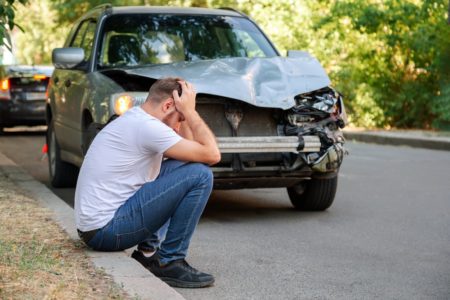Several accidents occur on U.S. roadways and can lead to severe injuries or deaths. One of the most dangerous types of accidents is a head-on collision, which is an accident that occurs when the front of one vehicle collides with the front of another vehicle that is traveling in an opposite direction.
Here is a deeper look at head-on collisions and how to seek compensation if you’ve been injured or lost a loved one due to a head-on caused by another driver’s negligence.
What Causes Head-on Car Collisions?

Like all car accidents, human error is the most common cause of head-on car collisions. Drivers who operate motor vehicles on public roadways must take reasonable actions to avoid causing physical harm or property damage to other roadway users. Lawyers commonly call this the driver’s duty of care. The proper actions expected of the driver due to their duty of care consist of operating the vehicle safely and following traffic laws.
An accident can result when a driver exhibits careless or reckless behaviors that are contrary to the duty they owe to other roadway users. Some of the most common examples of the type of carelessness and recklessness that causes head-on collisions are as follows.
Alcohol Impairment
Alcohol impairment creates progressive deficits in drivers’ skills to operate their vehicles safely. These deficits begin to appear after the first drink and become worse as the driver reaches the legal impairment limit for most adults over 21 of 0.08 grams of alcohol per deciliter of blood (g/dL).
Some of these deficits include:
- The inability to maintain lane position. When drunk drivers drift in and out of travel lanes, they risk colliding with other vehicles. If they drift into a nearby lane designated for opposing traffic, this can cause a head-on.
- Difficulty responding appropriately in emergencies. Alcohol impairment can cause both exaggerated and dull reactions, leaving the driver in an emergency driving situation to either veer wildly to avoid an obstacle on the roadway—even into an opposing travel lane, in some cases—or to not have enough of a reaction to the hazard to avoid it by swerving or braking.
- Difficulty controlling speed. Driving at an excessive speed makes it harder for the driver to maintain control of their vehicle, creating a higher likelihood of any accident, including a head-on.
- Difficulty making good driving decisions. Alcohol-impaired drivers commonly struggle with information processing and the ability to determine if their actions are safe. They can enter an opposing travel lane without even realizing it.
Distracted Driving
Three driving distractions can lead to head-on car collisions:
- Manual distractions cause the driver to take their hands from the proper position on the steering wheel, which can result in the driver needing an adequate ability to keep their vehicle in their lane.
- Visual distractions cause the driver to avert their eyes from watching the roadway, which can lead them to exit their lane and wander into an opposing travel lane.
- Cognitive distractions cause the driver to think about topics other than driving and can lead them to violate safe driving practices.
Speeding
Speeding makes it more difficult for a driver to maintain vehicle control. It also deprives them of the time needed to perceive a hazard and respond by braking or swerving and requires a greater stopping distance as the brakes work to slow and stop the vehicle’s weight.
The force of an accident involving at least one speeding vehicle traveling increases, resulting in more serious injuries and even a loss of the ability of road safety structures, such as guardrails and medians, to keep the vehicle from traveling into opposing travel lanes after an accident.
Fatigued Driving
While fatigued driving is commonly associated with certain types of drivers, including commercial truck drivers, as well as night shift or swing shift workers, any driver who has not had adequate rest or who has a medical condition such as sleep apnea that impairs the quality of their rest can find themselves drowsy behind the wheel.
Driver fatigue mimics many signs of drunk driving, such as the inability to maintain lane position or make good driving decisions. A tired driver is at significant risk of leaving their travel lane, which can mean colliding with another vehicle head-on.
Unfamiliarity With the Road
When a driver travels in an unfamiliar area, they’re often required to pay closer attention to the road signs and signals to protect themselves and other drivers from accidents. Head-on collisions sometimes occur because a sober driver unfamiliar with the roadway misses the warning signs and enters the travel lane in the wrong direction.
Previous Accidents
In some cases, the force of a collision between two vehicles, or even one vehicle and a fixed object such as a concrete structure, can force a car from that accident into another travel lane, resulting in a secondary or chain-reaction crash.
Why Are Head-On Collisions So Dangerous?
While only about 2 percent of all traffic-related accidents involve a head-on collision, the Insurance Information Institute reports that more than 10 percent of all traffic fatalities result from this type of accident.
The reason head-on collisions result in so many injuries and fatalities is that the force of the collision is increased by the forward motion of both vehicles. Even if both vehicles are traveling at a slow speed, they face a higher incidence of injury. For example, when two vehicles collided head-on while traveling at a speed of 25 miles per hour, the force of the collision will be the equivalent of a vehicle colliding with a wall at 50 miles per hour.
The higher the speed, the greater the impact, and the harder the impact, the less likely the vehicle’s safety features, such as seat belts and airbags, will be to prevent serious injury.
The Types of Injuries Incurred in Head-On Collisions
Head-on collisions commonly result in serious injuries, including spinal cord injuries and traumatic brain injuries. Both of these injury types are referred to in the legal arena as catastrophic, as they produce a high likelihood of permanent disabilities that will impair the sufferer’s ability to earn an income or even to live independently simply due to the body part that was injured.
Other catastrophic injuries that can also be suffered in head-on collisions include traumatic limb amputations and damage to the spinal vertebrae and discs.
Head-on collisions can also cause injuries such as:
- Broken bones in any part of the body result from the crash’s increased force.
- Internal damage, which can permanently impair the function of bodily organs or result in dangerous internal blood loss, is known as a hemorrhage.
- Severe lacerations to the face result from broken glass from the windshield.
- Burns result from a fire caused when flammable liquids leak out from the vehicle due to the accident, and occupants of the vehicle make contact with those chemicals or with a flame that is caused if the liquids ignite.
Seeking Compensation for Injuries or Losses Caused by Head-On Collisions
When an individual is injured or killed due to a head-on collision caused by another driver’s negligence, compensation for the expenses and impacts of that injury or loss can be sought through the relevant claims process. These processes involve filing a claim against the at-fault party’s relevant liability insurance policy (typically an auto liability policy).
If the insurance provider who services that policy fails to compensate the claim outright or to engage the claimant in a settlement agreement, the claim can also be filed as a lawsuit. This is a legal claim filed in civil court that asks a judge or jury to hear the case and make determinations on matters of liability and compensation.
The Personal Injury Claims Process
This is the process used by individuals injured in an accident.
Personal injury claimants who have been injured in head-on collisions can seek compensation for expenses and impacts that include:
- All reasonable costs are associated with medically treating the injury incurred in the accident.
- Wage loss resulting from time away from work while the claimant is recovering from their injuries.
- Lost earning capacity if the injuries are permanent and the claimant can no longer work or earn as they did before the accident.
- The cost of repairing or replacing the claimant’s vehicle damaged in the collision.
- Physical pain and suffering, emotional distress, and loss of the enjoyment of life incurred by the claimant due to the trauma of the accident and the seriousness of their injuries.
The Wrongful Death Claims Process
When an individual dies in a head-on collision caused by another’s negligence, certain family members of the deceased—such as their surviving spouse, parents, or children, can benefit from a wrongful death claim.
This type of claim is similar to the personal injury claims process and is used to obtain compensation for expenses and impacts the deceased’s family or estate incurred due to the accident, such as:
- Costs associated with the medical treatment of the deceased’s final injuries.
- A funeral service and burial or cremation.
- Loss of services and support that the deceased provided to their family members.
- Loss of future wages and benefits that the deceased would have likely earned if they had survived the accident.
- Loss of comfort, companionship, love, guidance, or moral support incurred by the deceased’s loved ones.
The Importance of Hiring an Experienced Attorney to Help You With Your Claim
When navigating the personal injury claims process, one of the most important things an injured person or the family of someone who died in a head-on collision can do is hire an experienced car accident attorney to help them navigate the claims process.
An attorney can provide several services to assist their clients in obtaining the compensation they need, such as:
- Helping them determine who was liable for the accident and the relevant insurance policy held by the liable party that can compensate the claim.
- Valuing the claim to ensure that all expenses and impacts incurred due to the at-fault party’s negligence are included.
- Communicate with the insurance provider who services the at-fault party’s liability policy to negotiate a settlement.
- Filing a personal injury or wrongful death lawsuit within the statute of limitations for such claims. In most states, the statute of limitations is between 1-4 years after the date on which the injury or death occurred. Wrongful death claims often have a different statute of limitations than personal injury claims.
- Gathering the evidence and testimony to prove liability and the documentation needed to justify the claim’s value.
- Presenting the case in court.
- Assisting the claimant in obtaining the compensation owed due to a negotiated settlement or court award.
How Do Claimants Afford the Cost of a Car Accident Attorney?
Contrary to popular belief, the services of an experienced car accident attorney can be afforded by anyone who needs those services due to the contingent fee billing method most personal injury lawyers use.
This allows the claimant to wait to pay for their lawyer’s services until their claim has been compensated. If no compensation is received on the claim, the claimant does not have to pay for the attorney. However, if the claim is compensated, the attorney and their legal team are paid through a percentage of the compensation received.
If a head-on car collision injured you or killed a loved one, contact a car accident lawyer for your free case evaluation.

